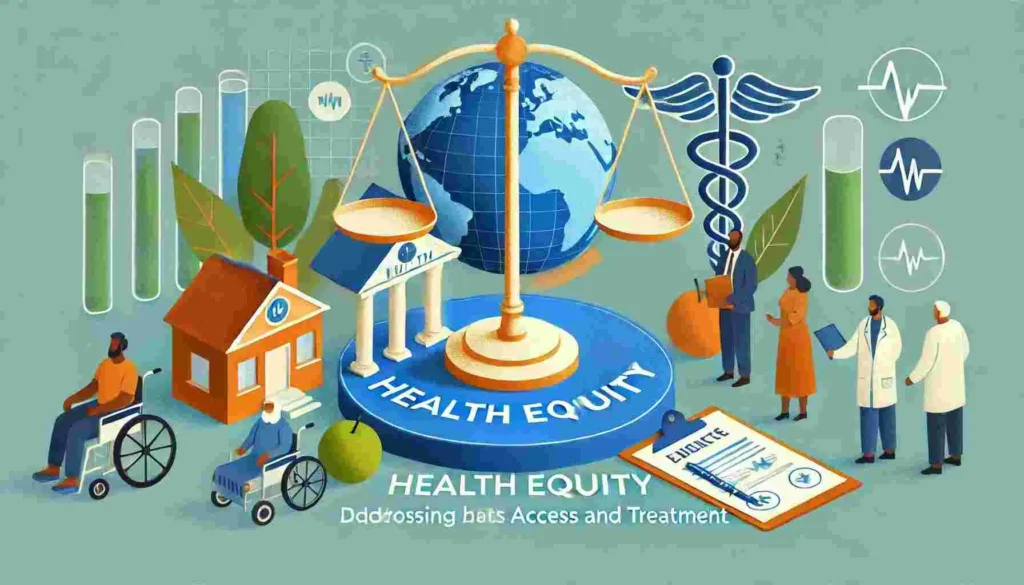
Health Equity: Addressing Disparities in Access and Treatment
Introduction to Health Equity
Health equity ensures that every individual has a fair and just opportunity to attain their highest level of health. It emphasizes the removal of barriers, such as poverty, discrimination, and systemic inequalities, which prevent people from accessing quality healthcare. For students and researchers, understanding health equity is vital for fostering innovation and developing strategies that can bridge existing gaps in healthcare delivery.
Keyphrases:
- Health equity definition
- Disparities in healthcare
- Access to quality treatment
The Importance of Health Equity
Health equity is a cornerstone of public health and social justice. It addresses not only the availability of healthcare services but also the quality and appropriateness of care provided to different population groups. Disparities in healthcare outcomes can stem from several factors, including socioeconomic status, geographic location, race, gender, and education. Researchers have consistently linked these disparities to higher rates of chronic illnesses and lower life expectancies among marginalized groups.
Cited Example:
“Health disparities reflect the unequal distribution of social determinants of health, including income and access to education.” – Social Determinants of Health: A Comparative Approach by Alan Davidson.
Historical Context of Health Disparities
The roots of health inequities can be traced back to historical injustices, such as segregation and discriminatory policies. For instance, limited access to healthcare facilities in rural or underserved urban areas has long been an issue. These systemic barriers have perpetuated a cycle of poor health outcomes among specific demographics.
Keyphrases:
- Systemic health inequities
- Historical impact on healthcare
Cited Example:
“The history of unequal healthcare access underscores the importance of policy interventions aimed at eliminating these disparities.” – The Social Transformation of American Medicine by Paul Starr.
Current Challenges in Achieving Health Equity
- Socioeconomic Barriers
Individuals from lower-income backgrounds often lack access to preventive care, nutritious food, and clean living environments. These barriers contribute to a higher prevalence of diseases like diabetes and hypertension. - Racial and Ethnic Disparities
Racial minorities, including African Americans, Hispanics, and Native Americans, experience significant disparities in healthcare outcomes. This includes limited access to advanced treatments and preventive services. - Geographic Inequalities
Rural areas often lack specialized healthcare providers and advanced medical facilities. This geographic disparity limits access to life-saving treatments for many individuals.
Cited Example:
“Geographical barriers play a crucial role in the unequal distribution of health resources.” – Rural Health and Aging Research by Wilbert Gesler.
Strategies for Addressing Disparities
Achieving health equity requires a multifaceted approach involving policymakers, healthcare providers, and communities. Key strategies include:
- Expanding Healthcare Coverage
Programs like Medicaid expansion have shown promising results in improving access for low-income populations. - Cultural Competency Training
Healthcare providers must understand and respect cultural differences to offer patient-centered care. - Community-Based Interventions
Engaging local communities in health promotion initiatives can reduce barriers and build trust.
Keyphrases:
- Medicaid expansion benefits
- Cultural competency in healthcare
Tackling Socioeconomic Barriers
To address disparities rooted in socioeconomic challenges, governments, non-profits, and healthcare organizations must prioritize accessible and affordable healthcare. Socioeconomic barriers, such as lack of insurance, low income, and unstable housing, significantly hinder an individual’s ability to seek timely medical care.
- Affordable Healthcare Policies
Expanding government-funded programs like Medicaid and increasing subsidies for private insurance can make healthcare more accessible to underserved populations. - Improving Health Literacy
A lack of knowledge about navigating the healthcare system exacerbates health inequities. Community workshops and digital health platforms can empower individuals with essential information about preventive care and treatment options. - Investing in Public Health Infrastructure
Investments in local clinics, mobile health units, and telemedicine can help reduce the burden of travel and financial stress for low-income families. These initiatives not only bring care closer to patients but also reduce the load on overcrowded hospitals.
Keyphrases:
- Health literacy programs
- Affordable healthcare solutions
Cited Example:
“Public health programs designed to improve infrastructure are vital to mitigating disparities.” – The Public Health Handbook by Michael Grossman.
Overcoming Racial and Ethnic Disparities
The systemic inequities faced by racial and ethnic minorities in healthcare settings call for urgent action. These populations often face implicit bias, lack of representation in clinical trials, and limited access to culturally sensitive care.
- Diversity in Healthcare Workforces
Encouraging diversity among healthcare professionals ensures that patients receive care from providers who understand their cultural and social contexts. - Bias Training for Providers
Mandatory training programs for healthcare workers can help identify and mitigate implicit biases that may affect decision-making and patient outcomes. - Community Outreach Programs
Partnering with trusted community leaders to deliver health education and screenings can foster trust and encourage underserved populations to seek care.
Keyphrases:
- Diversity in healthcare
- Addressing implicit bias
Cited Example:
“Racial disparities in care can be alleviated through inclusive policies and culturally aware practices.” – Health Equity and Racial Justice in Healthcare by Lillian Hall.
Bridging Geographic Gaps
Access to healthcare varies widely between urban centers and rural or remote regions. Geographic disparities often leave individuals in rural areas with limited resources and fewer options for specialized care.
- Telemedicine Expansion
Telehealth platforms have revolutionized rural healthcare by connecting patients with specialists without requiring travel. Increasing broadband access in remote areas is essential for the success of telemedicine. - Rural Healthcare Funding
Governments can allocate funds to build and sustain health centers in underserved areas. Offering incentives to medical professionals for working in rural locations can address staff shortages. - Transportation Solutions
Providing subsidized or free transportation for patients who need to visit medical facilities is another effective strategy for reducing geographic barriers.
Keyphrases:
- Telemedicine benefits
- Rural healthcare development
Cited Example:
“Digital health technologies can address rural healthcare challenges effectively.” – The Role of Telehealth in Bridging Healthcare Gaps by Jennifer Ames.
Advancements in Technology to Reduce Disparities
Innovations in medical technology and digital tools have created new opportunities to address health inequities. From AI-driven diagnostics to wearable health devices, technology offers promising solutions for underserved communities.
- Wearable Health Monitors
Devices that track vital signs and chronic conditions provide patients with timely alerts, helping them manage their health proactively. - Artificial Intelligence (AI)
AI can analyze vast amounts of health data to predict disease trends and identify at-risk populations, enabling targeted interventions. - Mobile Health Apps
Applications that offer health information, appointment scheduling, and medication reminders are particularly valuable for individuals with limited access to traditional healthcare systems.
Keyphrases:
- Role of AI in healthcare
- Wearable health devices benefits
Cited Example:
“Technology has the potential to democratize healthcare and reduce disparities worldwide.” – Digital Health for All: A Vision for Equity by Rachel Stevens.
The Role of Policy in Promoting Health Equity
Policy interventions are critical to ensuring that health equity becomes a reality. Legislation, funding, and regulation all play pivotal roles in shaping equitable healthcare systems.
- Universal Health Coverage
Universal healthcare models ensure that all individuals, regardless of income or employment status, can access necessary medical care. - Health Equity Audits
Policymakers can implement regular audits to identify disparities and evaluate the effectiveness of ongoing initiatives. - Social Determinants of Health (SDOH) Programs
Addressing factors such as housing, education, and employment through comprehensive policies can improve overall health outcomes for disadvantaged groups.
Keyphrases:
- Universal healthcare policies
- Addressing social determinants of health
Case Studies: Successful Health Equity Initiatives
- Medicaid Expansion in the United States
The Affordable Care Act’s Medicaid expansion provided millions of low-income individuals with access to healthcare. States that adopted the expansion observed significant improvements in health outcomes, including reduced mortality rates and increased preventive care utilization.Keyphrases:- Medicaid expansion outcomes
- Benefits of Affordable Care Act
“States with Medicaid expansion have seen marked reductions in preventable hospitalizations and improvements in financial security for low-income families.” – Healthcare Reform and Public Health by Patricia Hughes. - The Navajo Nation Community Health Representative Program
In addressing disparities in Native American communities, the Navajo Nation developed a program to train community health representatives (CHRs) who provide culturally appropriate care. These representatives bridge the gap between formal healthcare systems and traditional healing practices, ensuring that patients receive holistic care.Keyphrases:- Native American health programs
- Culturally competent healthcare
“CHRs have effectively reduced healthcare access barriers by integrating traditional and modern approaches.” – Native American Health Initiatives by Rachel Martinez. - Reducing Maternal Mortality in Rwanda
Rwanda has become a global model for reducing maternal mortality through its community health worker program. The program focuses on educating women about prenatal care and ensuring timely access to medical facilities during childbirth.Keyphrases:- Maternal health improvement strategies
- Role of community health workers
“Rwanda’s innovative approach highlights the importance of empowering local communities to achieve health equity.” – Global Health Success Stories by James Knight.
The Role of Education in Advancing Health Equity
Education is a cornerstone of health equity. By raising awareness about disparities and empowering individuals with knowledge, communities can take active roles in improving their health outcomes.
- Training Future Healthcare Providers
Universities and medical schools are incorporating health equity into their curricula to prepare future professionals for addressing disparities. Courses on cultural competence, social determinants of health, and ethics in healthcare delivery have become integral components of training.Keyphrases:- Health equity education
- Medical training in cultural competence
- Community-Based Education
Local health education campaigns tailored to specific populations can address barriers such as language differences and low literacy rates. For example, diabetes prevention programs in Hispanic communities that utilize bilingual materials have been highly effective.Cited Example:
“Education at the community level has shown measurable benefits in chronic disease prevention.” – Health Literacy and Community Empowerment by Amanda Scott. - Student-Led Initiatives
Students across disciplines are driving innovative projects aimed at improving health equity. For example, public health students have developed mobile clinics and telehealth solutions for underserved communities, merging education with practical impact.Keyphrases:- Student involvement in health equity
- Role of interdisciplinary projects
The Future of Health Equity
- Technology as a Catalyst
Emerging technologies like artificial intelligence, blockchain for medical records, and remote monitoring systems will continue to play a transformative role in health equity. These tools have the potential to streamline access, reduce costs, and improve health outcomes for underserved populations.Keyphrases:- Role of technology in health equity
- Future healthcare innovations
- Global Collaboration
Tackling health disparities requires international cooperation. Organizations such as the World Health Organization (WHO) and non-governmental organizations (NGOs) are partnering with governments to implement global health equity frameworks. These collaborations aim to address pressing issues such as vaccine distribution, infectious disease control, and disaster response.Cited Example:
“Global efforts to ensure equitable access to healthcare are vital for managing future pandemics.” – Global Health Equity Initiatives by Clara Benson. - Policy Reform and Advocacy
Advocacy for stronger policies that prioritize marginalized populations will remain critical. Strengthening labor laws, improving workplace health standards, and advocating for universal healthcare are steps toward a more equitable future.Keyphrases:- Health policy advocacy
- Universal healthcare impact
Measuring Progress in Health Equity
To ensure continued progress, robust systems for measuring and evaluating health equity must be in place.
- Data Collection and Analysis
Comprehensive data on health outcomes across demographics is essential. Governments and organizations are investing in tools that disaggregate data by income, race, gender, and geography to identify specific areas requiring intervention. - Health Equity Indexes
Several countries are adopting health equity indexes to measure disparities and assess the effectiveness of implemented policies. These indexes provide benchmarks and facilitate accountability among stakeholders. - Community Feedback Mechanisms
Engaging communities in evaluating healthcare programs ensures that solutions are tailored to their needs and challenges. Regular feedback loops between healthcare providers and patients foster trust and improve service delivery.Cited Example:
“Community-based evaluation ensures that healthcare initiatives are relevant and effective.” – Participatory Health Metrics by Karen Walker.



